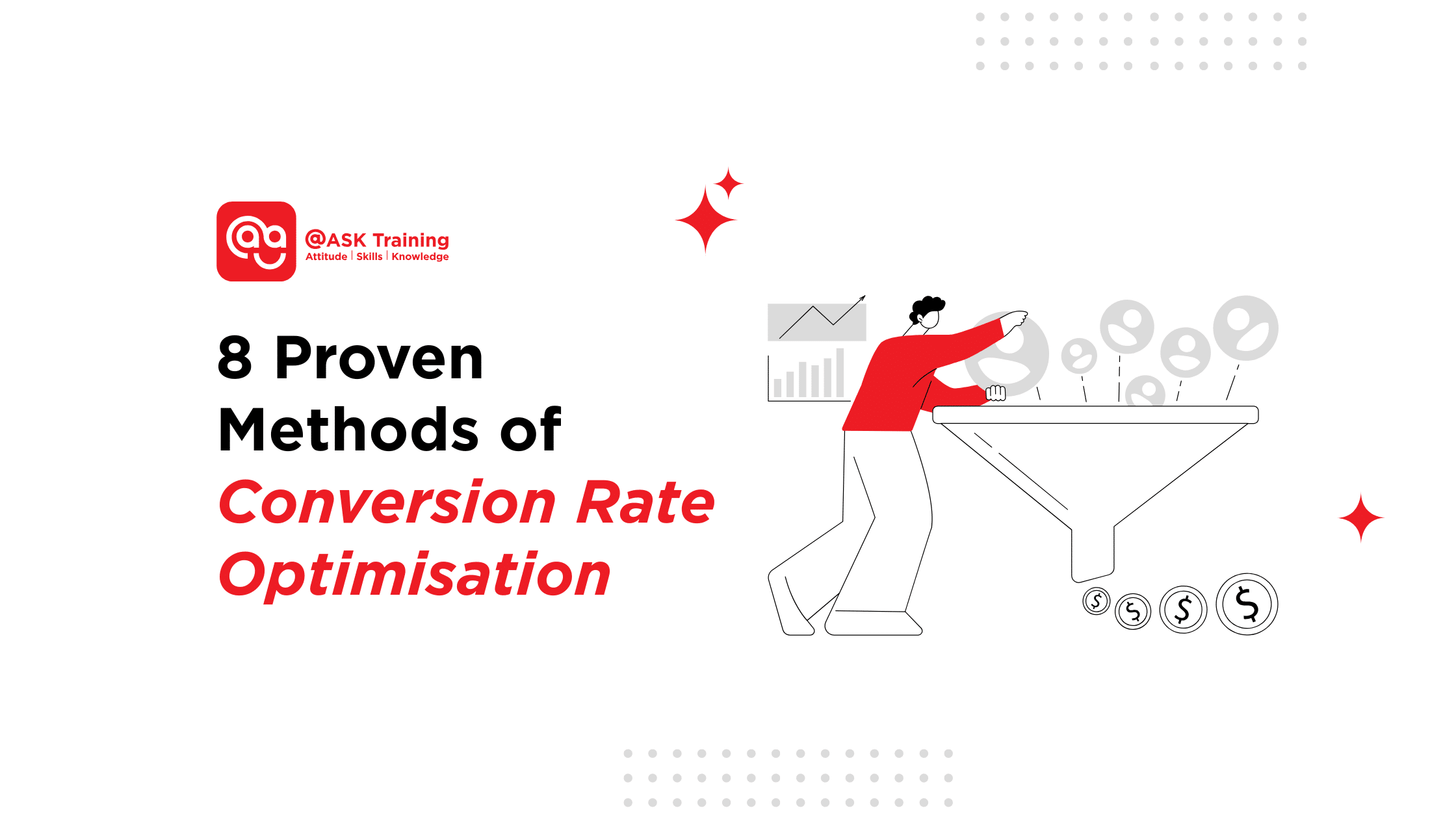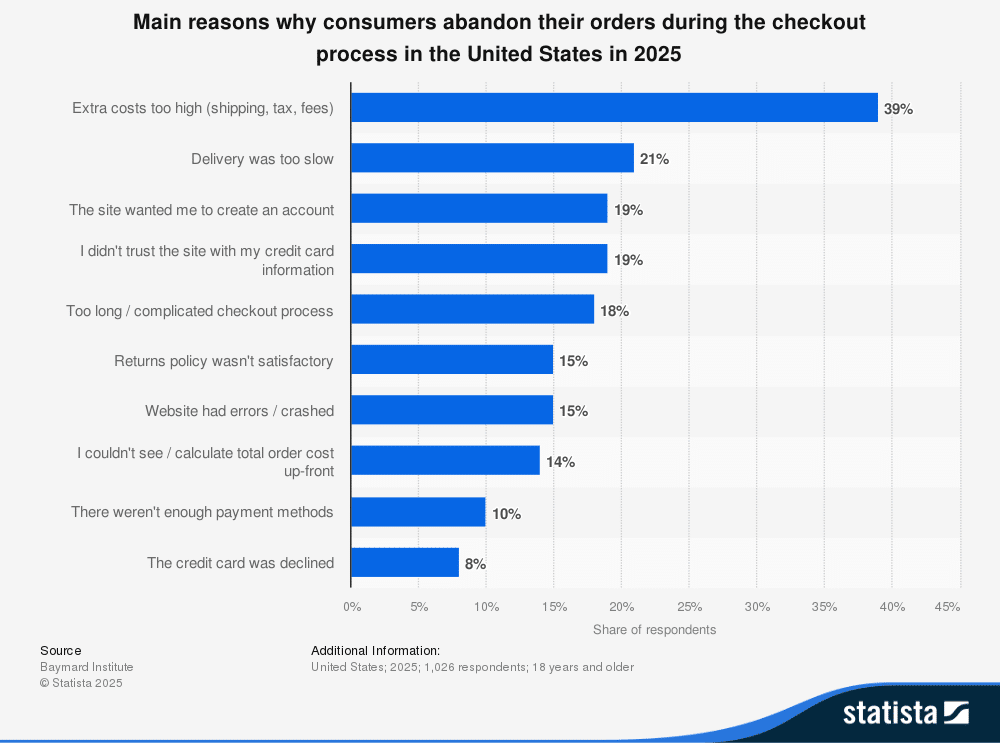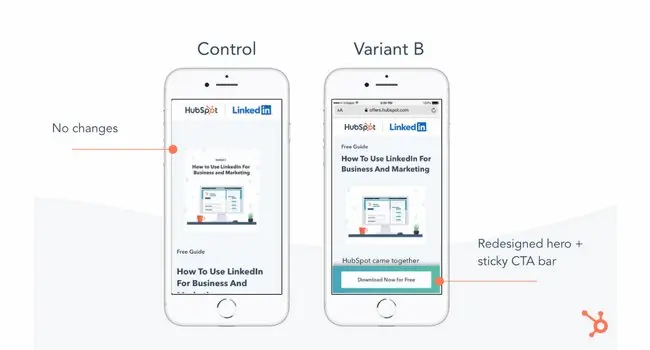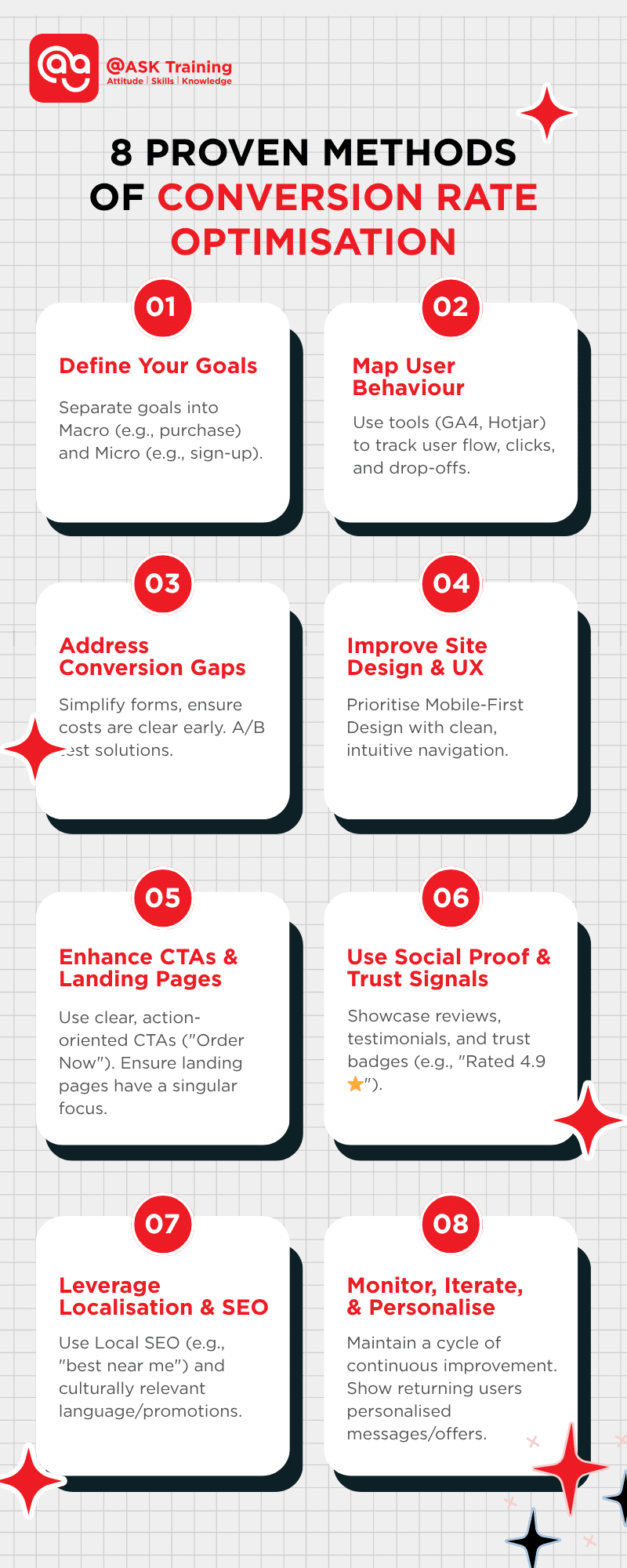
Let’s be honest: in Singapore’s competitive digital market, getting visitors to your website is a great first step, but it’s what happens next that truly counts.Are they just browsing, or are they taking the actions that grow your business? This, right here, is where the magic of strategic Conversion Rate Marketing comes into play.Think of effective conversion rate optimisation (CRO) less as a technical chore and more like being a great host. You’re understanding what your guests need and making it incredibly easy for them to say “yes”.
This guide will walk you through eight proven, actionable strategies for website optimisation in Singapore, blending UX, CRO, and local know-how to help you turn more visitors into loyal customers.
Let’s dive in!
#1 Clearly Define Your Conversion Goals
The first rule of conversion rate optimisation? Know your destination. Before you can improve, you must define what success looks like for your business.
We break this down into two types of goals:
- Macro-Conversions: Your primary business objectives.
- Completing a purchase
- Submitting a contact form for a quote.
- Micro-Conversions: Smaller steps that signal interest and build towards a macro-goal.
- Signing up for your newsletter.
- Clicking a “Chat on WhatsApp” button.
- Downloading a brochure.
This is important because defining clear goals allows for personalisation. HubSpot research shows that:
- Personalised CTAs convert 42% more viewers into leads than generic ones.
- CTAs targeted to a specific audience can perform a massive 202% better.
You can only create these high-performing, personalised prompts if you first have a crystal-clear goal in mind.
Your Actionable Tip:
Align every website element with these goals. A clear, specific call-to-action (CTA) like “Order Now” or “Get A Quote” is infinitely more effective than a vague “Click Here”.
CTA Example ‘Upgrade Now’ by Grammarly
How This Helps You Convert:
Clarity eliminates confusion. When users know exactly what to do, they are far more likely to do it. This focus is the foundation of effective conversion optimisation.
Now that you know your destination, wouldn’t you want to see if your visitors are on the right path?
#2 Map & Analyse User Behaviour
To fix problems, you first need to find them. This is where you become a digital detective, using tools to see exactly how users interact with your site.
Your Toolkit:
- Google Analytics 4: For tracking user flows and drop-off points.
- Hotjar / Microsoft Clarity: For heatmaps and session recordings that show you where users click, scroll, and get stuck.
Proof in Practice:
HubSpot Academy utilised Hotjar to go beyond guesswork by analysing session recordings and heatmaps. They identified that users faced difficulties with a particular, critical module, based on observed behaviour rather than assumptions.
After implementing targeted improvements to streamline the user experience, they saw a notable 10% rise in course enrolments.
Example Scenario:
You might discover that many users add your “Bubble Tea Gift Sets” to their cart but abandon the process when they see the shipping options. That’s a critical clue!
How This Helps You Convert:
By seeing your site through your visitors’ eyes, you can pinpoint and eliminate frustrations, guiding more people to complete that purchase or enquiry.
Spotting where users struggle is key, but what do you do with that information?
#3 Identify & Address Conversion Gaps
Those spots where users leave? We call those conversion gaps. Often, the bottlenecks are something simple:
- Lengthy, complicated forms.
- Missing information (e.g., shipping costs hidden until late).
- Confusing page layouts.
Reasons for Abandoning Purchases (Source: Statista)
According to a Statista survey, the top reasons for cart abandonment include extra costs like shipping (39%), being forced to create an account (19%), and a lengthy checkout process (18%).
Actionable Tip:
This is your chance to experiment! A/B test a shorter form or clearer messaging, such as simplifying an 8-field contact form down to just Name, Email, and Message.
Or why not ask them directly? A quick poll on your exit page saying, “Was something missing?” can provide golden insights.
Advanced Tactic: Use Exit-Intent Technology
For visitors who are about to leave your site without converting, tools like HubSpot’s exit-intent software can trigger a last-minute targeted offer. This could be:
- A discount code to counteract “extra costs.”
- A reminder of your free shipping threshold.
- A one-click guest checkout option to avoid account creation.
This allows you to directly address their reason for abandoning in real-time, capturing leads and sales that would otherwise be lost.
How This Helps You Convert:
Smoothing out these friction points makes the journey to conversion feel effortless, preventing frustration and cart abandonment.
Fixing these gaps is all about creating a smoother, more intuitive experience for your users.
#4 Improve Site Design & UX
In mobile-first Singapore, a website that isn’t optimised for all devices is costing you sales. A seamless User Experience (UX) is non-negotiable.
Key Principles:
- Mobile-First Design: Ensure your site is thumb-friendly and loads quickly on smartphones.
- Clean Navigation: Menus should be simple and intuitive.
- Familiar Layouts: Don’t reinvent the wheel; use layouts users already understand.
Real-World Example: HubSpot’s Mobile CTAs
The Problem: Analytics revealed that on mobile:
- Users were 27% less likely to click a CTA.
- Less than 75% of users scrolled far enough to even see the offer button.
The Hypothesis: The CTAs were not prominent or accessible enough on smaller screens.
Before vs After CTA Redesign (Source: HubSpot)
The Action: They ran an A/B test with a redesigned mobile layout featuring a more prominent, sticky CTA.
The Result: The winning variant increased its mobile conversion rate by 10%, projecting to generate thousands more leads per month.
If you’re selling a product, your “Order Now” button must be unmissable and easy to tap on a mobile screen. No pinching or zooming allowed!
How This Helps You Convert:
A site that’s a pleasure to use builds trust and keeps people engaged, making them far more likely to complete that order.
A great design sets the stage, but your calls to action are the stars that direct the performance.
5. Enhance CTAs & Landing Pages
Your Call-To-Action (CTA) and the landing page it leads to are a team; both must be optimised to work together seamlessly. It must be obvious, compelling, and written in clear, action-oriented language.
A great CTA is less effective if the landing page doesn’t deliver on its promise.
Your Actionable Tip:
Take a lesson from HubSpot’s analysis of fantastic landing pages: the best ones maintain a singular focus.
The headline, supporting copy, imagery, and CTA all work in unison to guide the user toward one specific action, removing all distractions.
Example:
CTA and Landing Page for HubSpot’s Social Media Trends Report
A landing page for a free Social Media Trend report shouldn’t have links to your company blog or main services. Its only goal is to get that download.
Never assume one CTA is best. Test your language! A/B test different phases:
- “Book Now” vs. “Secure My Slot”
- “Order Your Favourites” vs. “Start My Order”
How This Helps You Convert:
A strong, relevant CTA cuts through hesitation by telling users exactly what to do next, making them far more likely to follow through.
Even the perfect CTA needs a little backup to build trust, especially with savvy audiences.
#6 Use Social Proof & Trust Signals
Local consumers are savvy and look for validation. Build confidence by showcasing that others trust you.
According to BrightLocal’s research:
- 76% of consumers always or regularly read online reviews when browsing for local businesses.
- 88% of consumers trust online reviews as much as a personal recommendation.
- 72% of consumers say positive reviews make them trust a local business more.
How to Implement:
- Showcase local testimonials and Google Reviews.
- Display badges like “Rated 4.9 ⭐️ on Google” or “Over 1,200 Happy Customers in Singapore.”
- Feature logos of recognised partners or platforms (“Available on GrabFood & Shopee”).
Examples:
Example of featured logos of recognised media partners on @ASK Training’s website
Example of past graduate testimonials on @ASK Training’s website
How This Helps You Convert:
When new visitors see that fellow Singaporeans have had great experiences, their confidence in your brand skyrockets.
This local trust is key, and it directly contributes to making your content feel truly relevant.
#7 Leverage Localisation & SEO Synergies
Effective website optimisation in Singapore needs a local flavour. Your content must resonate on a cultural level.
Users are far more likely to engage with a brand that feels familiar and integrated into their daily life. This means using local language, referencing well-known services, and aligning with national initiatives.
Example: Grab & STB Partnership
STB x Grab Collaboration for Singapore Tourism
A brilliant example of this principle in action is the partnership between the Singapore Tourism Board (STB) and Grab.
Instead of a generic tourism campaign, they leveraged hyper-localised, digital tools like Grab’s Dine-Out Discovery to help visitors explore diverse neighbourhoods with curated, geo-targeted food and retail options.
Your Actionable Tip:
- Local SEO: Target long-tail keywords like “best nasi lemak near me” or “affordable home cleaning services SG”.
- Local Flavour: Weave in local references, highlight “islandwide delivery”, or run promotions tied to events like Singapore’s National Day.
How This Helps You Convert:
When your content feels like it was made just for them, it creates a powerful emotional connection that makes users feel understood and encourages them to act.
Of course, what works today might not work tomorrow, which is why your work is never truly done.
#8 Monitor, Iterate, & Personalise
CRO marketing is a cycle of continuous improvement, not a one-time task. The goal is to get more personalised over time.
Your Actionable Tip:
- Review Analytics Regularly: Spot new trends or performance dips.
- Get Personal: Utilise tools to display personalised messages to returning visitors. e.g., “Welcome back! Still thinking about those durian puffs?”
- Segment Offers: Show pet food promotions to users who previously viewed dog-related pages.
How This Helps You Convert:
Personalisation shows you’re paying attention, serving up content that feels tailor-made. This dramatically increases relevance and conversions.
Wrapping Up
Mastering conversion rate optimisation isn’t a single project; it’s the ongoing process of building a more effective and profitable digital presence for your Singaporean business.
By embracing these eight strategies, from defining clear goals to leveraging local trust signals, you move beyond just attracting traffic.
You start systematically increasing website conversions and building a site that actively works to grow your business.
Remember, the most successful CRO marketing strategies are built on a cycle of analyse, test, and refine. You don’t need to implement everything at once.
Your Next Step:
- Start small. This week, pick just one tactic from this list.
- Could your CTAs be stronger?
- Is there a trust signal you could add?
- Do you know your top exit page?
Audit your site, make a change, and measure the result. This is how sustainable growth happens!
Explore our related guides on local SEO and SEM strategies to create a comprehensive digital marketing plan that drives real results for your business in Singapore.
Ready to Move from Theory to Practice?
Understanding the theory is the first step. Mastering the tools and techniques is what will transform your results.
Deepen your expertise with @ASK Training’s SEO, Website Analytics and Optimisation courses. Gain practical, expert-led skills in analytics, optimisation, and digital strategy that you can apply immediately.
Courses worth exploring:
Enrol with us today and transform your knowledge into results!
Related Courses
- WSQ Website and Landing Page Optimisation
- WSQ Digital Marketing Analytics (Google Analytics)
- WSQ Advanced Digital Content Marketing
◆◆◆









